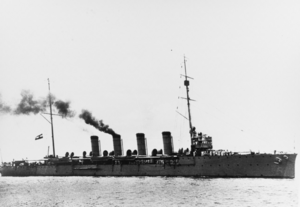 Admiral Spaun under way
| |
| History | |
|---|---|
| Name | Admiral Spaun |
| Namesake | Hermann von Spaun |
| Builder | Pola Navy Yard, Pola |
| Laid down | 30 May 1908 |
| Launched | 30 October 1909 |
| Commissioned | 15 November 1910 |
| In service | 1910–1918 |
| Out of service | 1918 |
| Homeport | |
| Fate | Transferred to State of Slovenes, Croats and Serbs on 31 October 1918 |
| Name | Admiral Spaun |
| Acquired | 31 October 1918 |
| Fate | Seized by Italian forces on 9 November, handed over to the Allied powers on 10 November 1918 |
| Name | Admiral Spaun |
| Acquired | 9 November 1918 |
| Fate | Ceded to the United Kingdom under the Treaty of Saint-Germain-en-Laye in 1920 |
| Name | Admiral Spaun |
| Acquired | 1920 |
| Fate | Sold for scrap in Italy and broken up between 1920 and 1921 |
| General characteristics | |
| Type | Scout cruiser |
| Displacement |
|
| Length | |
| Beam | 12.8 m (42 ft 0 in) |
| Draught | 5.3 m (17 ft 5 in) |
| Installed power |
|
| Propulsion | 4 shafts; 6 × steam turbines |
| Speed | 27.07 knots (50 km/h; 31 mph) |
| Complement | 320–327[a] |
| Armament |
|
| Armour |
|
SMS Admiral Spaun[c] was a scout cruiser built for the Austro-Hungarian Navy. Named for Admiral and Marinekommandant (Commander-in-Chief of the Navy) Hermann von Spaun, Admiral Spaun was constructed shortly before World War I. Laid down at the Pola Navy Yard in May 1908, the cruiser was launched in October 1909. Admiral Spaun was commissioned into the Navy just over a year later, in November 1910. The first ship of the Austro-Hungarian Navy to be constructed with steam turbines, her design later influenced the construction of the Novara-class cruisers.
Admiral Spaun served as the flotilla leader of the Second Torpedo Flotilla at the outbreak of World War I and was stationed out of the naval base at Cattaro. She saw limited action during the first year of the war, and following Italy's declaration of war on Austria-Hungary in May 1915, the cruiser participated in a bombardment of the Italian coastline. Throughout the rest of 1915, Admiral Spaun engaged in various operations across the Adriatic Sea. While she was involved in missions centred mostly around Trieste in the northern Adriatic for the rest of the war, Admiral Spaun also participated in many of Austria-Hungary's naval operations as far south as the Otranto Barrage and the Strait of Otranto, alongside the Novara-class cruisers.
Emboldened by the Austro-Hungarian victory during the Battle of the Strait of Otranto, and determined to break the Otranto Barrage with a major attack on the strait, Austria-Hungary's newly appointed Commander-in-Chief of the Fleet Miklós Horthy organised a massive attack on the Allied forces with Admiral Spaun, alongside seven battleships, three cruisers, four destroyers, four torpedo boats, and numerous submarines and aircraft, but the operation was abandoned after the battleship Szent István was sunk by the Italian motor torpedo boat MAS-15 on the morning of 10 June.
After the sinking of Szent István, the ships returned to port where they remained for the rest of the war. When Austria-Hungary was facing defeat in October 1918, the Austrian government transferred its navy to the newly formed State of Slovenes, Croats and Serbs in order to avoid having to hand the ship over to the Allies. Following the Armistice of Villa Giusti in November 1918, Admiral Spaun was seized by the Allies and transferred to Italy, where she participated in a victory parade through the Venice Lagoon in March 1919. The final distribution of Austria-Hungary's former navy was settled under the terms of the Treaty of Saint-Germain-en-Laye in 1920. Admiral Spaun was ceded to the United Kingdom before being sold for scrap and broken up between 1920 and 1921.
Cite error: There are <ref group=lower-alpha> tags or {{efn}} templates on this page, but the references will not show without a {{reflist|group=lower-alpha}} template or {{notelist}} template (see the help page).